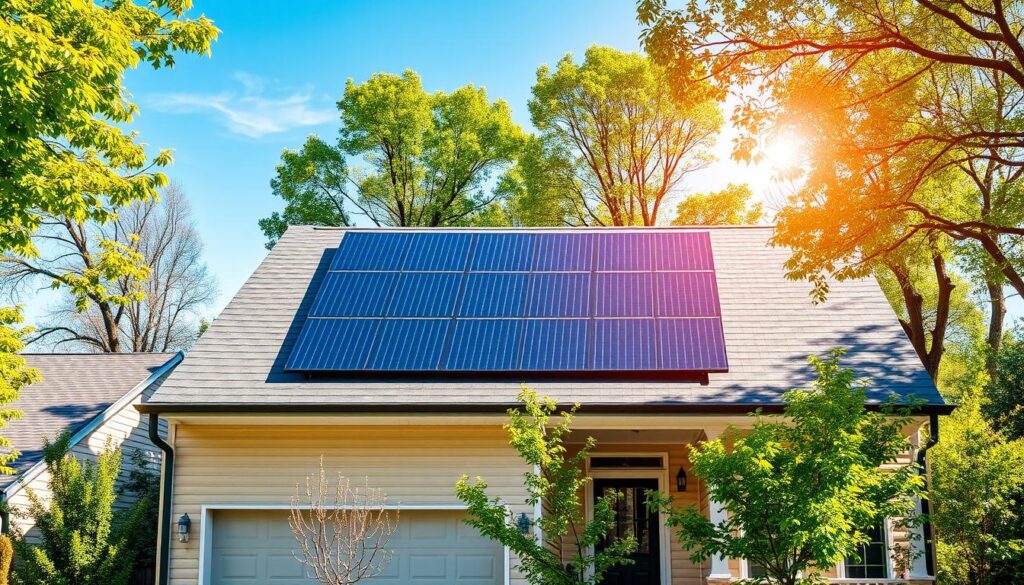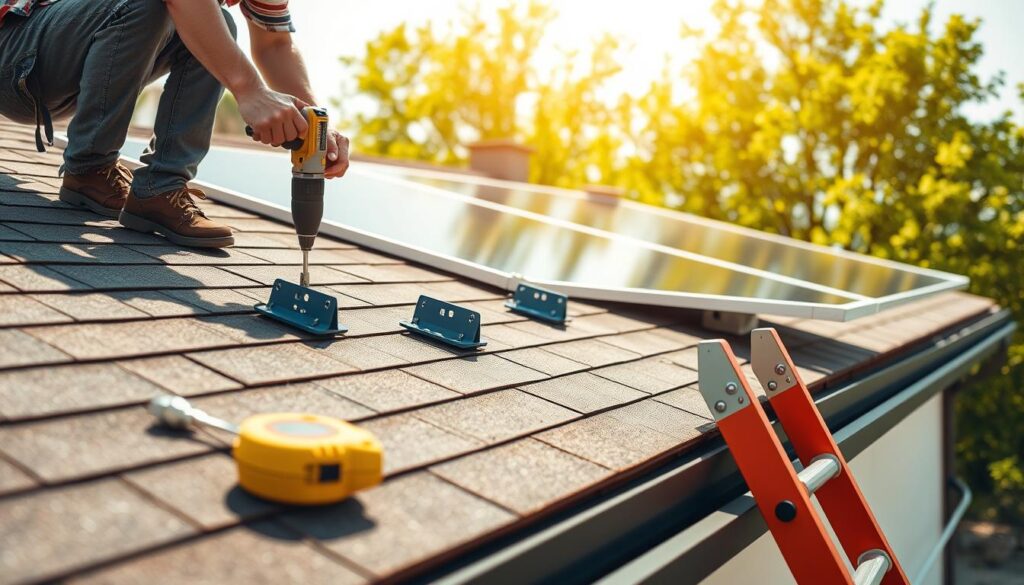More homeowners are turning to solar panels as a way to produce their own energy. This guide will help you learn how to install solar panels on your own. It’s a step-by-step guide to making your home energy-independent.
You’ll learn about solar panel technology, the tools you need, and how to assess your home’s solar potential. We’ll also cover roof preparation, electrical wiring, and connecting to the grid. This guide is perfect if you want to cut down on carbon emissions or save on energy costs.

Key Takeaways
- Understand the basics of solar panel technology and system components
- Assess your home’s solar potential and determine optimal panel placement
- Prepare your roof and install the mounting system for solar panels
- Safely wire the solar system and connect it to your home’s electrical grid
- Achieve energy independence and reduce your environmental impact
Understanding Solar Panel Basics and System Components
Homeowners starting to use solar power need to know the basics. This includes understanding solar panel systems and their parts. We’ll cover the different solar panels for homes, the tools needed for installation, and how a solar system works.
Types of Solar Panels for Residential Use
There are many solar panel options for homes. You can choose from monocrystalline, polycrystalline, and thin-film panels. Each has its own benefits like efficiency, cost, and looks. This lets homeowners pick the right solar panels for their needs.
Essential Equipment and Tools Needed
- Solar panels
- Solar inverter
- Mounting system
- Wiring and electrical components
- Safety gear (gloves, goggles, etc.)
- Power tools (drill, saws, etc.)
To set up a solar panel system, you need the right tools. This kit helps you install safely and efficiently. It turns your home into a green, sustainable place.
Understanding Solar Power System Architecture
The design of a solar power system is key. It affects how energy flows and the system’s efficiency. A home system includes panels, an inverter, a mount, and electrical parts. Knowing this helps homeowners choose well and install their systems successfully.
| Component | Function |
|---|---|
| Solar Panels | Convert sunlight into direct current (DC) electricity |
| Inverter | Convert DC electricity to alternating current (AC) for home use |
| Mounting System | Securely hold the solar panels in place on the roof or ground |
| Electrical Components | Safely distribute and manage the flow of electricity |
Knowing these basics helps homeowners make smart choices. They can then successfully install their solar panel systems.
Site Assessment and Planning for Maximum Solar Efficiency
To get the most out of solar energy, you need a good site assessment and planning. Homeowners looking to add rooftop solar panels as a green home improvement should first check their home’s solar potential. They also need to figure out the best spot for the panels.
Calculating Your Home’s Solar Potential
Start by figuring out your home’s solar potential. Look at things like:
- Roof orientation and tilt angle
- Shading from nearby trees, buildings, or other obstructions
- Average daily and annual sunlight exposure
- Roof space availability and suitability
By checking these, you can see how much solar energy your home can get. This helps you pick the right size and setup for your solar panels.
Determining Optimal Panel Placement
After figuring out your home’s solar potential, find the best spot for the panels. Consider:
- Maximizing exposure to direct sunlight throughout the day
- Minimizing shading from nearby structures or vegetation
- Ensuring the panels are oriented towards the south (in the Northern Hemisphere) for maximum energy production
- Optimizing the tilt angle of the panels to match the latitude of the location
Choosing the right spot for your panels is key. It helps your solar system work better, saving you money and giving you a good return on your investment.
Local Regulations and Permit Requirements
Before starting your rooftop solar panel project, check local rules and permits. You might need:
- Obtaining necessary permits from the local authorities
- Adhering to building codes and zoning laws
- Ensuring the solar system meets electrical and safety standards
- Securing any necessary approvals from homeowners’ associations or landlords
By following these steps, you can make sure your solar project is done right. This avoids problems and keeps your project on track.

“Careful planning and site assessment are the keys to a successful solar installation that maximizes energy production and cost savings.”
Preparing Your Roof and Mounting System
Starting a solar panel installation means getting your roof and mounting system ready. This step is key for your solar energy system’s safety and life span. It’s important whether you’re living off-grid or connected to the grid.
Check your roof’s condition first. Look for leaks, cracks, or loose shingles. Fix any damage to make sure your roof is solid for the solar panels. You might need to replace old roofing or strengthen the roof itself.
Then, figure out the best spot for your solar panels. Think about the roof’s direction, angle, and any shadows to get the most energy. Use tools like a solar path finder to find the best spots on your roof.
- Make sure the roof can handle the weight of the panels and mounting system.
- Look for any things like chimneys or vents that might block the panels.
- Know the local building rules and get any needed permits before starting.
The type of mounting system you pick depends on your roof. You can choose from roof racks, ground mounts, or pole mounts. Always follow the maker’s guide to make sure it’s safe and weatherproof.

Always put safety first when installing solar panels. Wear the right gear, be careful on high places, and get help if you’re not sure about something.
Electrical Wiring and Connection Guidelines
Proper electrical wiring and connection are key steps in installing solar panels. Before starting, learn the safety rules to ensure a safe and successful DIY project.
Safety Protocols for DIY Installation
Always follow local electrical codes and wear the right safety gear. This includes insulated gloves and safety glasses to avoid electrical shocks. Make sure to turn off the power before connecting or modifying your home’s electrical system.
Connecting to Your Home’s Electrical System
Connecting your solar system to your home’s electrical system needs careful planning. Talk to a licensed electrician to understand your local needs and ensure a smooth connection. Ground the system, install circuit breakers, and wire the panels according to the manufacturer’s instructions.
Installing the Solar Inverter
The solar inverter is vital for changing DC from solar panels to AC for your home. Follow the manufacturer’s instructions for installation. Choose the right location, connect the wiring, and program the inverter for best performance.
FAQ
What types of solar panels are recommended for residential use?
For homes, monocrystalline and polycrystalline silicon panels are top choices. They are efficient and reliable for solar power systems.
What essential equipment and tools are needed for a DIY solar panel installation?
You’ll need solar panels, an inverter, mounting hardware, wiring, and conduit. Don’t forget safety gear, tools, and a multimeter. Having the right tools ensures a safe and successful installation.
How do I determine the optimal placement and orientation of my solar panels?
First, calculate your home’s solar potential. Then, find the best spot for your panels. Consider roof direction, tilt, shading, and local rules. Proper planning boosts your system’s energy output.
What safety protocols should I follow during the DIY solar panel installation?
Safety is key. Follow local electrical codes and use protective gear. Working with electricity requires caution. A professional electrician can help ensure a safe setup.
How do I connect my solar panel system to my home’s electrical grid?
Connect your system by installing the inverter and wiring it to your main panel. You need to know about electrical systems and follow local rules and utility requirements.
What are the typical steps for preparing my roof for solar panel installation?
Start by checking your roof’s condition and making repairs. Then, install the mounting system. This step is crucial for a secure and lasting installation.
Do I need to obtain any permits or approvals before installing my solar panels?
Yes, check with local authorities and your utility company about permits and regulations. Getting the right permits ensures a compliant installation.
How can I maximize the energy efficiency and cost savings of my DIY solar panel system?
To get the most from your system, think about panel orientation and tilt. Also, keep your system maintained and watch its performance. This will help save energy and money over time.









